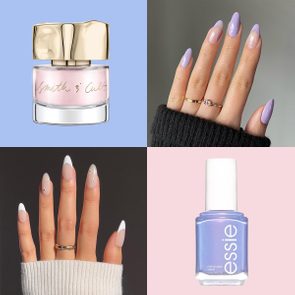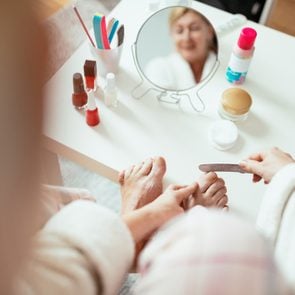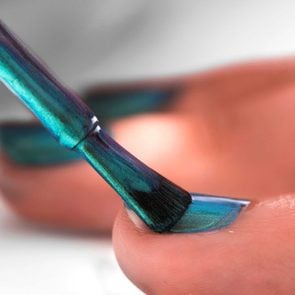What Is a Russian Manicure—and Is This TikTok Trend Safe?
Updated: Jan. 09, 2023
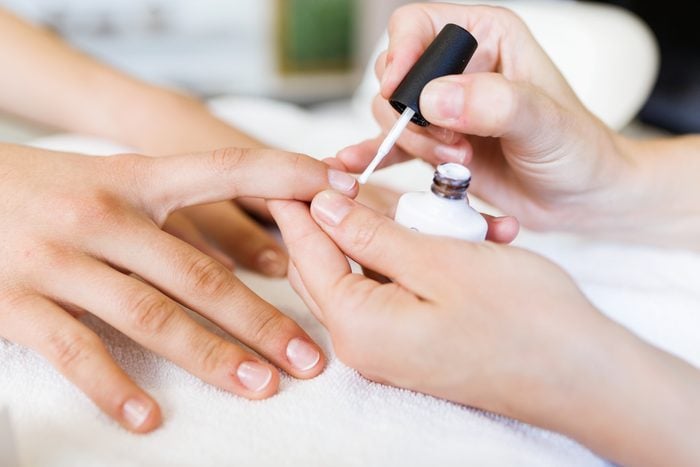
Is this specialized manicure really all that? Learn about the benefits and risks of Russian manicures before you book one.
Russian manicures are trending on TikTok (right next to skin cycling!), and a growing numbers of swanky nail studios are now offering these specialized “manis” to clients. Even A-listers like Kylie Jenner and Hailey Bieber are reportedly fans. But what is a Russian manicure, exactly, and why are many dermatologists so quick to ring alarm bells about them?
Sometimes called “dry” or “e-file” manicures, Russian manicures are all about the cuticle—that layer of clear skin at the bottom edge of your nail that protects your nails as they grow. Fans looking for how to make nail polish last claim these long-lasting manicures make their nails stronger and shinier. The new nail trend of Russian manicures also presents an alternative to hunting for the best nail polish, non-toxic nail polishes, the best gel nail polish, or liquid latex for nails, as the focus of a Russian manicure is almost solely on cuticles.
During more traditional manicures, your nail technician may ask if you would like your cuticles cut or pushed back. With a Russian manicure, however, the technician will use an electronic file or drill to remove the extra cuticle under the nail bed for a clean trim. Your nail bed is that pinkish soft tissue under the hard part of your nail or nail plate.
Because of this, detractors remain focused on the risks associated with removing cuticles, including infections and bleeding. It may be better to stick with the best cuticle oils to nourish and strengthen dry nails instead of opting for this new nail trend. Here’s why.
What is a Russian manicure, exactly?
There are multiple steps involved in this specialty treatment, and it can take up to three hours to complete, says Ian Austin, cofounder of Gilded Ritual, a therapeutic nail bar in New York City’s Tribeca that offers Russian manicures. In contrast, a normal manicure takes about 30 minutes.
Step 1: Remove old polish
Your manicurist uses the e-file or drill to remove gel nail polish from your last mani. “You need to leave 10 to 15 percent of the previous base on your nail plate or the hard part of your nail,” Austin explains. “You don’t want to grind too far.”
It’s tricky and takes lots of training, he says. “You need complete control of the nail drill and an understanding of how far you can go down.” During training, technicians at Gilded Ritual practice this skill on quail eggs by removing the color from the raw egg without breaking it.
If your nails have soft gel or polish rather than hard gel, the color will likely be removed with acetone or non-acetone nail polish remover instead, he says. “These lacquers are a lot thinner, and there is too much risk to use only an instrument to remove it,” he says.
Step 2: Trim the cuticle
Your nail technician uses scissors to cut the cuticle off all the way up to the gray zone or outermost part, also known as your epicuticle, Austin says. Think of the gray zone as the safe zone. “Once you wet the cuticle,” he explains, “the gray zone is a physical marker separating the living cuticle from the dead skin, and there is a slight discoloration where the change occurs.”
Step 3: Prep the nail bed
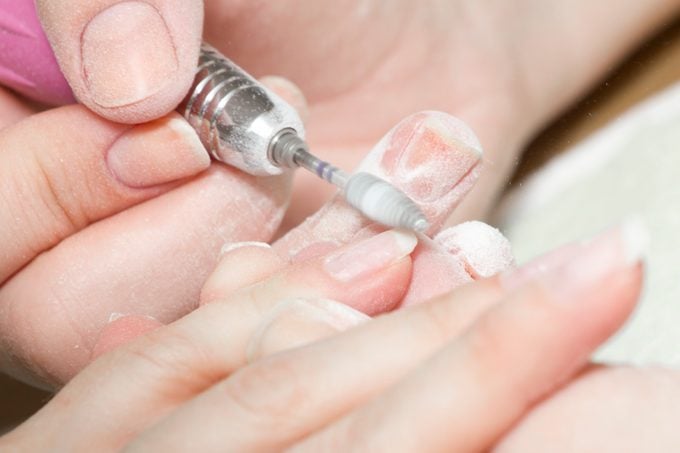
Next, it’s time to buff the nail with the drill. This step aims to prepare the nail bed, make skin smooth, and avoid hang nails, or tiny, torn pieces of skin next to your nail. “The cuticle work and nail-bed prep will help get a very even and clean surface, so when it grows out there won’t be any chipping between the gel and cuticle,” Austin says.
There is a risk of damaging the nail bed and the cuticle during these steps, so always make sure your nail technician has received special training in Russian manicures, Austin says. There are many certification courses available. And never attempt this yourself.
Step 4: Apply a base coat
Your technician applies the base coat evenly over your nail bed.
Step 5: Polish the nails
The final step is the gel polish application. “The cuticle is cleaned, and the nail plate is ready for polish application,” Austin says. As with a regular mani, you’ll select a trendy spring nail color to finish your look.
How much do Russian manicures cost?
These specialized manicures cost more than your run-of-the-mill manicure. They usually run about $70 to $125, Austin says. A basic manicure costs about $20. Prices vary, based on where the salon is located, and whether you add any bells or whistles such as a massage or special type of polish or nail art design finishing.
What are the benefits of a Russian manicure?
Your Russian manicure results last much longer than your average manicure. “A 20-minute manicure, in the best-case scenario, lasts about a week,” Austin says, “while a properly done Russian manicure can last around four or five weeks.” So you get more bang for your buck, and also fewer trips to the salon. “The main client getting a Russian manicure is looking to have advanced cuticle therapy and nail plate prep,” he adds. “Their main goal is quality.”
There’s also no question that Russian manicures look impeccable. They give the appearance of a completely flawless, Instagram-worthy mani—but even so, they aren’t without serious risks to the long-term health of your nails. The Russian manicure may even find its way onto the list of the worst beauty trends that should never have happened.
Are Russian manicures safe?
The risks of Russian manicures far outweigh any benefits, stresses Jeanine Downie, MD, a board-certified dermatologist in Montclair, New Jersey. Here’s why: Your cuticles are trimmed down to the proximal nail fold, which is located on the bottom of the nail and connected to the cuticle. “This can allow bacteria and fungus in and cause significant nail infections or persistent fungus,” she says. “It can also permanently alter the structure of your nail, weaken your nail, and cause bleeding.”
Trimming down to the nail fold can also cause hypersensitivity to your nail from hand products such as nail polish, perfumes, hand creams, and hand sanitizers. “The skin is so thin, and the nail fold has been destroyed, so you become hypersensitive and may develop contact dermatitis, or itchy, scaly patches of skin,” Dr. Downie says. The last thing you want from a manicure is a skin irritation or rash.
Adam Friedman, MD, professor and chair of dermatology at George Washington School of Medicine and Health Sciences in Washington, DC, agrees. “Due to the rapid movement of the e-file ‘bits,’ the nail may initially appear ‘buffed,’ but I worry the injury to the skin surrounding the nail and nail matrix could be significant,” he says. “The injury could enhance the ability of pathogens to enter where they don’t belong and cause infection.”
The American Academy of Dermatology advises leaving cuticles alone when getting any sort of manicure. Although the results of a Russian manicure may initially look good, it’s probably not worth risking infection or long-term nail damage. You’re better off doing your own DIY manicure at home.
Next, check out our list of the best press-on nails that give you a gorgeous manicure instantly.
Sources:
- Ian Austin, cofounder of Gilded Ritual therapeutic nail bar in New York City
- Adam Friedman, MD, professor and chair of dermatology at George Washington School of Medicine and Health Sciences in Washington, DC
- Jeanine Downie, MD, board-certified dermatologist in Montclair, New Jersey
- American Academy of Dermatology: “How to trim your nails”

